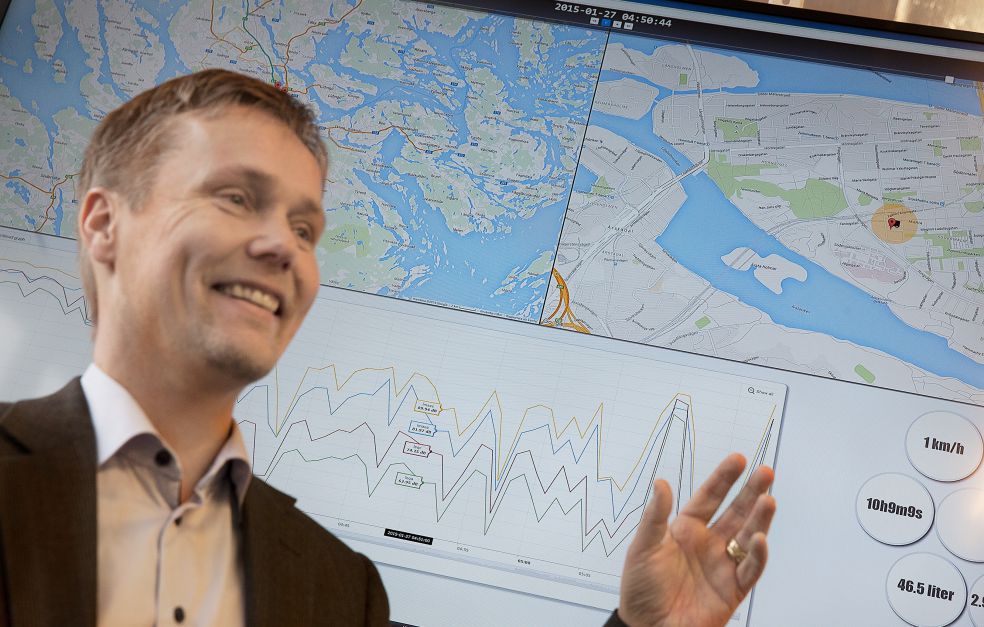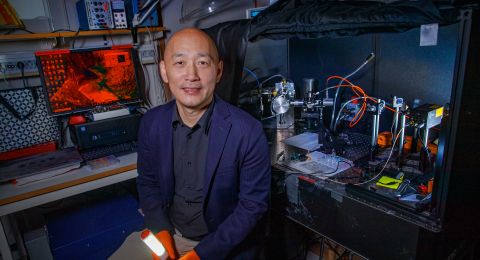
Project Grant 2015
Engineering the Interconnected Society: Information, Control, Interaction
Principal investigator:
Karl Henrik Johansson, Professor of Control Engineering
Co-investigators:
John Baras
Kristina Höök
Mikael Johansson
Mikael Skoglund
Institution:
KTH Royal Institute of Technology
Grant:
SEK 25,4 million over five years
The Integrated Transport Research Laboratory (ITRL) at KTH is set up for experiments. A couple of quadricopter drones fitted with claws are about to perform a task. Protective netting and mattresses on the floor mark the test area.
“We want to develop a mathematical theory for the interconnected, cyber-physical society. To do so, we are carrying out experiments that simulate fairly simple interactions between self-driving vehicles and people in an urban environment, for example,” says Karl Henrik Johansson, Professor of Control Engineering.
The ways we communicate and exchange information have changed radically in step with rapid developments in computing and IT. The next quantum leap will be the Internet of Things and cyber-physical systems, in which billions of things and systems will be connected to each other. Computers in various forms, digital devices, transport, health care, laundry rooms, and electric power systems – basically everything – will become interconnected.
“Systems working together in this way will be a predominant feature of society. Humans will always be involved in all these systems, computing power, and some kind of machine: something physical interacting with its surroundings.”
The problem is that current tools and theories used by engineers cannot cope with these huge quantities of complex information, human interaction and decision making.
Johansson heads a project supported by the Knut and Alice Wallenberg Foundation whose goal is to develop new scientific methods that it is hoped will rationalize the interconnected society and make it more reliable. Five research teams at KTH are involved in the project, and experiments are also being carried out at the Mobile Life lab in Kista, north of Stockholm. Johansson elaborates:
“Our collaboration is going to be really interesting because the teams involved come from such a variety of disciplines. We will be interlinking topics such as network technology with interaction design, psychology and mathematics. This is a new approach, and we don’t really know where it will take us.”
Systems of systems
The researchers are trying to envision the technical solutions and systems we will have in 30 years, and what fundamental limitations we will face.
“It is essential to understand these systems, so we can develop technologies that are as good as possible for desired societal development. The greatest challenge is to understand systems in which different technical solutions interact – how these ‘systems of systems’ should be designed, and, in particular, how they should interact with humans.”
One application for greater knowledge about how interactive systems impact each other may be in urban planning. For instance, in a few years the automobiles on our roads will be completely self-driving, but they will communicate with one another. Our smart homes will involve both interaction between devices, and with power systems. Johansson adds:
“The transition from semi-autonomous systems to completely autonomous ones will give rise to extremely interesting scientific questions that no-one has really examined yet.”
It is anticipated that technology will be more concealed in future, built in everywhere like in sci-fi movies. The research teams want to study what happens when a human being is not an observer, pilot or operator, but is a part of the system – when the human, the computer and the machine form a single entity.
Security and privacy are naturally key issues when the internet is connected to existing infrastructure. The inception of cyber systems increases technical as well as social complexity; many different systems and people are involved.
Johansson believes there must be guarantees constraining the way systems can behave. There may be serious consequences if something goes wrong. And if someone manages to hack into a system, they will not only gain access to information, but will also be able to impact the physical world, by stopping the traffic in a major city, for example.
“A new view of the human role will be needed when we become a part of the system.”
Mathematics and psychology
Individual and group human behavior is a key piece of the puzzle in creating the new theories, particularly as regards various decision-making situations. In engineering terms, there are very precise ways of measuring digital information. It is harder to measure the ways that humans communicate. Johansson explains:
“We want to formalize human information exchange in the same way.”
The drone gets tangled up in the protective netting, and one of the young researchers extricates it. At present, this is usually what happens. Everything is fine as long as things work. But we can always be sure that something unexpected will occur.
“In practice, human intervention is often needed to solve the problem. We want to systematize solutions of this kind, try to express human behavior in mathematical terms so we can build robust and secure cyber systems.”
Text: Susanne Rosén
Translation: Maxwell Arding
Photo: Magnus Bergström





